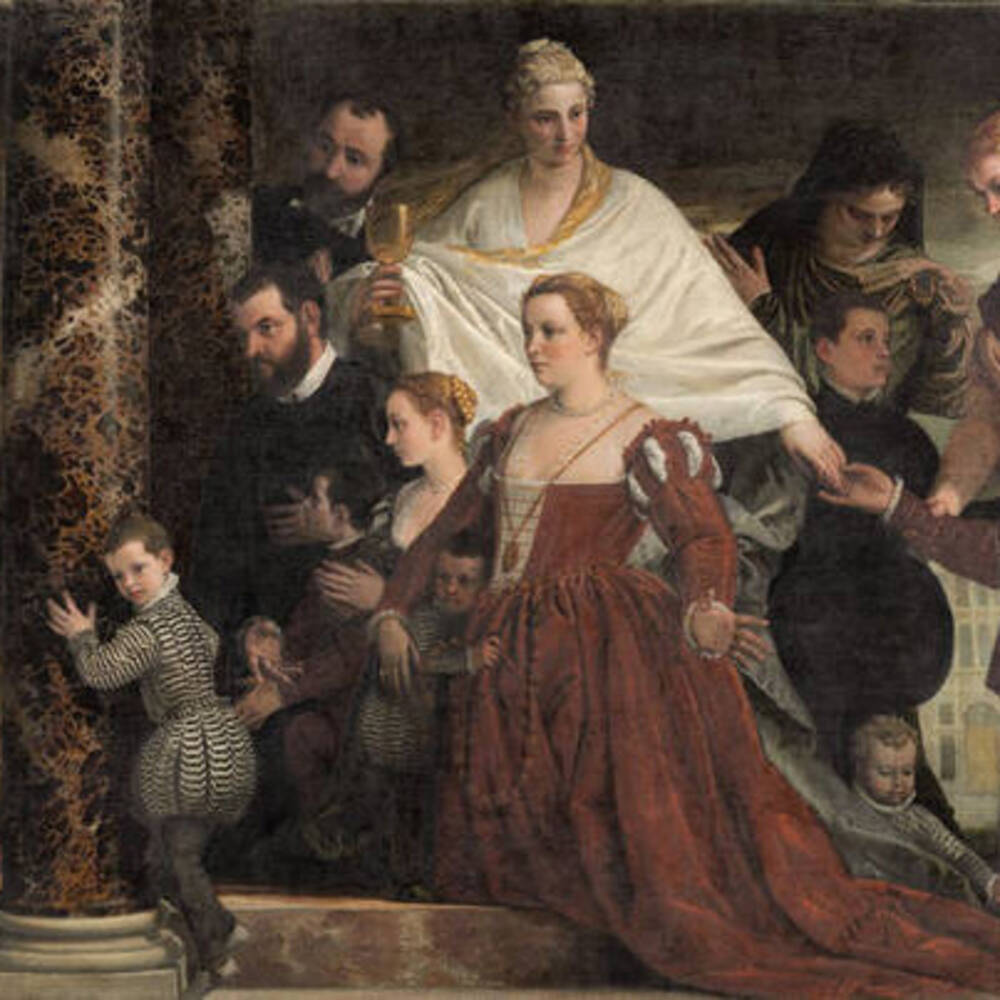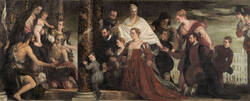The Cuccina family was one of the richest in Venice. For the banquet hall of their Palazzo – on the right in the picture – they commissioned four large paintings from Veronese. Here, the family are gathered before the Virgin and Child. They are accompanied by the three Christian virtues of Faith, Love and Hope. St John the Baptist and St Jerome, as well as an angel, flank the throne. This painting cycle now has many areas of discolouration, especially in the blues and greens.
Further Media
In addition to the The Madonna of the Cuccina Family, Veronese’s cycle of these large-scale works includes three scenes from the life of Christ – The Adoration of the Magi, The Wedding at Cana where Jesus turned water into wine, his first public miracle, and The Bearing of the Cross.
To integrate a family portrait into a series of such key biblical scenes certainly says a lot about the Cuccina family’s sense of importance. Nonetheless, since they were not aristocratic, they could not appear in the same space as the Virgin Mary and the saints – that privilege was reserved for nobles. Here, Veronese painted two columns into the scene to separate the divine and earthly spheres – and the Cuccina family adhere to the social conventions of their day and devoutly remain in their assigned area.
There is, though, a symbolic link to the heavenly sphere. The two men kneeling either side of the enthroned Virgin Mary are John the Baptist and Saint Jerome. These were the patron saints of two Cuccina forebears who started the cloth trade and founded the family’s legendary wealth – the wealth now allowing their palazzo to be decorated with such magnificent paintings.
The grey and black sky may lend this scene a certain drama – but that was not the artist’s original intention. Veronese actually painted the sky and the water in the Grand Canal in a luminous blue. The pigment he used for the colour was smalt, derived from pulverised blue potassium glass. But down the centuries, the pigment has faded and discoloured, while the oil used to bind the pigment has turned black. This is also why the Virgin Mary’s cloak no longer has any trace of its original blue. The red and green tones in the painting were also originally far brighter, and have faded.
Veronese used a very special pigment for the red gown worn by the woman in the centre kneeling on the step. She is Zuanna, wife of Alvise Cuccina, then head of the family. The Cuccina family had a monopoly on the cochineal trade. A scarlet coloured dye for material, cochineal was so expensive it was weighed against silver. To reflect this family business, Veronese rendered the dress in a glaze made from genuine cochineal.
Yet despite comprehensive restoration of all four paintings in the Cuccina cycle, many colours are still no longer visible. They also can’t be simply replaced since, of course, restoration aims to preserve the object as it is. In that spirit, we just have to accept the painting we see is not solely Veronese’s work, but also the work of time.
- Location & Dating
- c. 1571
- Material & Technique
- Oil on canvas
- Dimenions
- 167 x 416 cm
- Museum
- Gemäldegalerie Alte Meister
- Inventory number
- Gal.-Nr. 224

